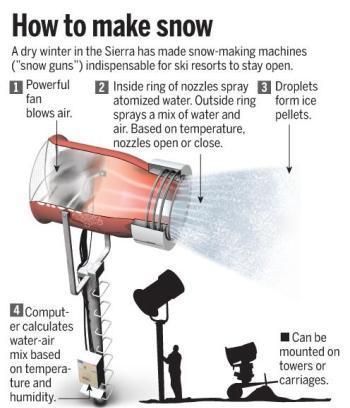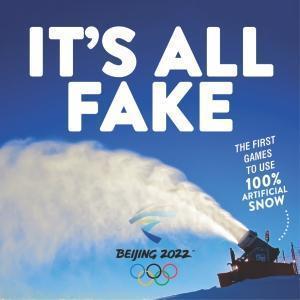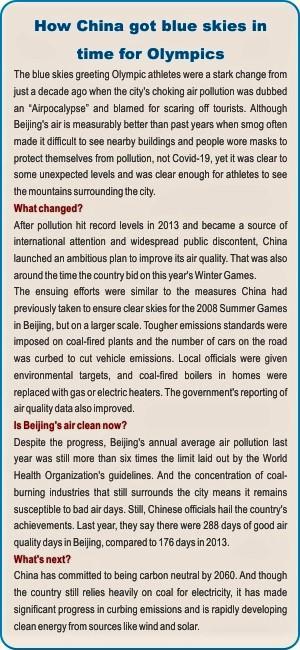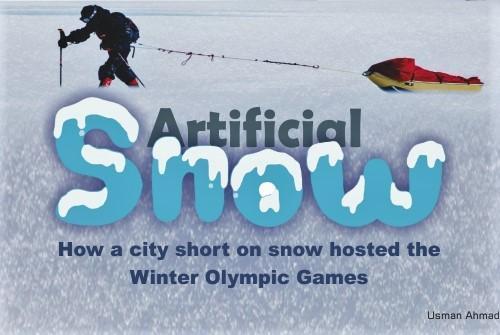Artificial Snow
How a city short on snow hosted the
Winter Olympic Games
 As the planet warms and the weather becomes increasingly more erratic, natural snow is becoming less reliable for winter sports, which forces venues to lean more on artificial snow. Machine-made snow has played a major role in winter sports for decades, even in snowier places like Norway, Switzerland and Colorado. For decades the problem of snow gave the organisers of the Winter Olympics chills. In 1960, at Squaw Valley in California, the snow didn’t arrive until a day before the games began. Sixteen years later, at Innsbruck in Austria, soldiers brought in truckloads of the stuff.
As the planet warms and the weather becomes increasingly more erratic, natural snow is becoming less reliable for winter sports, which forces venues to lean more on artificial snow. Machine-made snow has played a major role in winter sports for decades, even in snowier places like Norway, Switzerland and Colorado. For decades the problem of snow gave the organisers of the Winter Olympics chills. In 1960, at Squaw Valley in California, the snow didn’t arrive until a day before the games began. Sixteen years later, at Innsbruck in Austria, soldiers brought in truckloads of the stuff.
That changed for the 1980 games at Lake Placid, in New York state, which the organisers called the “weather-proof” Olympics. They were the first to supplement nature’s powdery dump with man-made flakes. But the 2022 Games took it one step further: None of the snow was real. At both the alpine skiing venue in Yanqing, a mountainous Beijing suburb, and at the biathlon, cross-country, freestyle, nordic, ski jumping and snowboarding venues in Zhangjiakou, a ski destination 100 miles northwest of the host city, the temperatures regularly dip below freezing, but natural monthly snowfall is best measured in centimeters. The Olympics cannot rely on that. So, they have to be sure the snow is there when they start.
What is artificial snow?
Snow that is injected with water to harden it and then treated with chemicals to keep the hardened snow in place is a form of artificial snow that is recommended for winter competitions. According to an analysis published by Loughborough University, just ten of the twenty venues that have hosted the Winter Olympics since 1924 will be able to produce enough snow to organise an international-level tournament like the Winter Olympics by 2050. Artificial snow production is critical to the Winter Games’ survival.
How is it made?
 Most artificial snow is made using snow cannons. These spray water in front of a stream of compressed air. As the air’s cooling capacity falls, so does the amount of water that can be pumped through the machine. At -4°C, a snow cannon can operate at around 80% humidity. But if the outside temperature is -1°C, this must be reduced to around 30% humidity, requiring more energy to produce the same amount of snow. In Yanqing, where winters tend to be cold but dry, around 200 cannons blew snow across the slopes.
Most artificial snow is made using snow cannons. These spray water in front of a stream of compressed air. As the air’s cooling capacity falls, so does the amount of water that can be pumped through the machine. At -4°C, a snow cannon can operate at around 80% humidity. But if the outside temperature is -1°C, this must be reduced to around 30% humidity, requiring more energy to produce the same amount of snow. In Yanqing, where winters tend to be cold but dry, around 200 cannons blew snow across the slopes.
Other machines, known as snow lances, use the same principle as a snow cannon but on poles high above the ground, giving the water more time to freeze and fall as a fine snow dust. Some resorts add extra nucleators to the water to encourage ice to form, allowing snow to be made at higher temperatures. But many countries, including Austria and France, prohibit these kinds of additives because of their potentially damaging effects on plant growth.
 Traditionally, snow-making has relied heavily on snow guns and temperatures at or below freezing. To accommodate warmer temperatures and lower elevations, a different approach needs to be taken. To work around Mother Nature, TechnoAlpin – an Italy-based firm that China tapped to manufacture the snow required to cover the four outdoor event spaces around Beijing – began shipping a full arsenal of snow guns, fan-driven snow generators and cooling towers to Beijing in 2018. Among those machines was a new piece of technology used at a training center for China’s athletes: the SnowFactory.
Traditionally, snow-making has relied heavily on snow guns and temperatures at or below freezing. To accommodate warmer temperatures and lower elevations, a different approach needs to be taken. To work around Mother Nature, TechnoAlpin – an Italy-based firm that China tapped to manufacture the snow required to cover the four outdoor event spaces around Beijing – began shipping a full arsenal of snow guns, fan-driven snow generators and cooling towers to Beijing in 2018. Among those machines was a new piece of technology used at a training center for China’s athletes: the SnowFactory.
These devices have been generating artificial snow since November 2021. These machines make snow by pumping ice particles and a thin mist of water vapour out at the same time. Both of these particles are released into the air and combine to form snow, which eventually falls to the ground.
The problem with these methods is that they consume vast amounts of water and energy. The International Olympic Committee estimated that 49 million gallons of water was needed to produce snow for The Games, which is a lot when you consider how rapidly the world is running out of freshwater. It’s enough to fill 3,600 average-sized backyard swimming pools, or – more to the point – it’s a day’s worth of drinking water for nearly 100 million people.
Is it necessary to use artificial snow?
According to the ‘Slippery Slopes’ assessment, weather changes caused by global warming are endangering snow sports and limiting the number of acceptable venues for future Winter Olympics.
In a bid evaluation document, the International Olympic Committee stated that the Yanqing and Zhangjiakou venues for the 2022 Games would “have minimal annual snowfall and would rely completely on artificial snow.”
Almaty, a city in Kazakhstan with snowy winters, was another option, but Beijing was viewed as a safe bet after hosting the 2008 Olympic Games.
Environmental deterioration
China has promised to host a “green and clean” Olympics, powered entirely by renewable energy sources. Artificial snow production, especially when powered by renewable energy, can be energy and water expensive, and chemicals or biological additions are frequently used to improve quality and slow melt.
 Chemically treated water can reduce biodiversity and damage plants, and a slow melt means plant growth beneath the snowpack is delayed. Human-made snow should not be considered as a way to address climate change, according to Peter Speight, a British freestyle champion and Winter Olympian.
Chemically treated water can reduce biodiversity and damage plants, and a slow melt means plant growth beneath the snowpack is delayed. Human-made snow should not be considered as a way to address climate change, according to Peter Speight, a British freestyle champion and Winter Olympian.
He further explained, “It’s useful for making physical snow for people to use. However, it consumes a lot of water and energy, and it doesn’t help solve climate change.”
‘A danger to athletes’

According to a research paper, athletes are more at danger when competing on artificial snow since it tends to create a faster and harsher surface, which might result in more serious injuries when they fall.
Laura Donaldson, a British freestyle skier who competed in the 2002 Winter Olympics in Salt Lake City, believes that athletes are more likely to get injured when competing on artificial snow.
“If freestyle super pipes are formed from snow-making machines in a poor season, the walls of the pipe are solid, vertical ice and the pipe floor is solid ice,” she told, adding that “This is dangerous for athletes.”
The writer is a member of staff.



